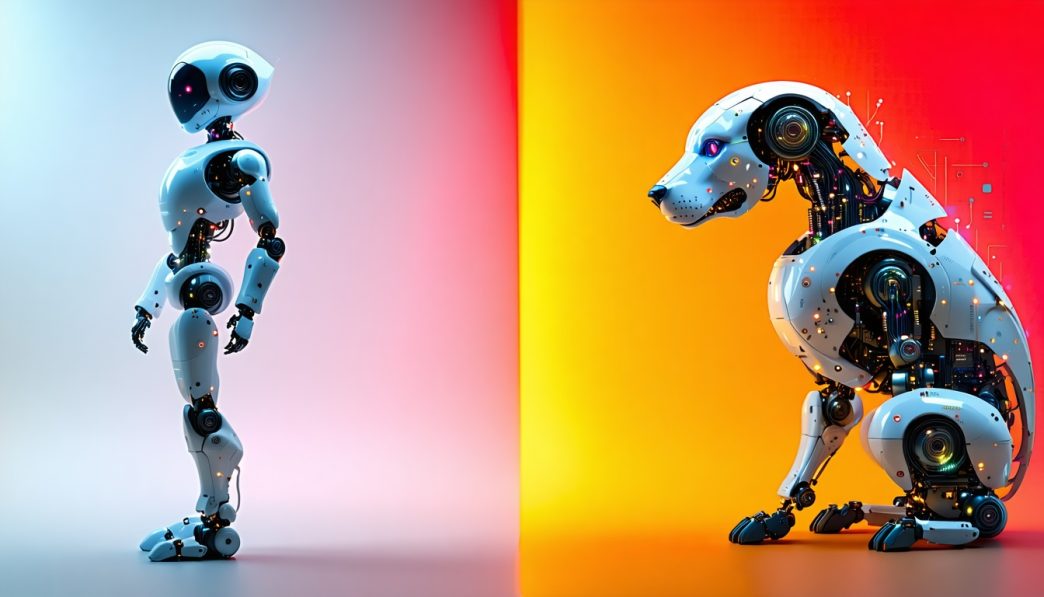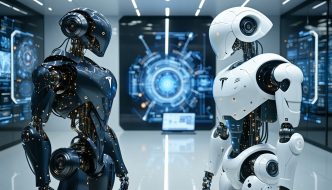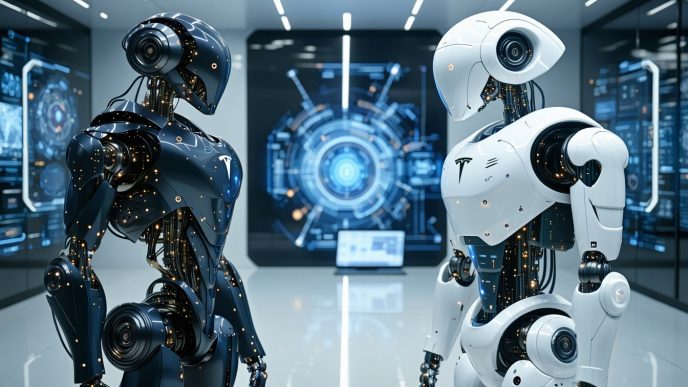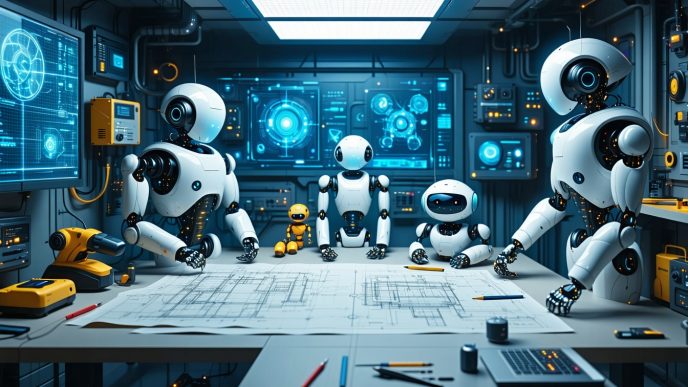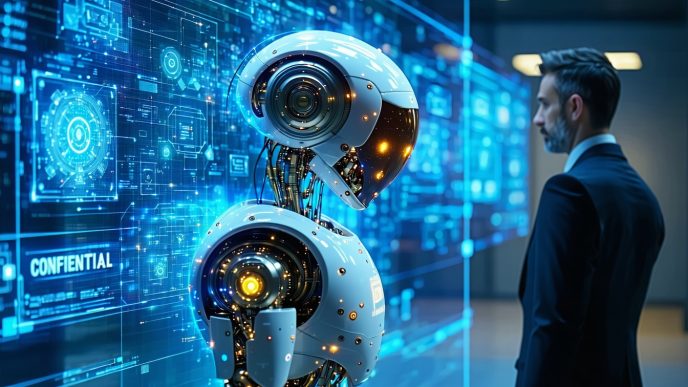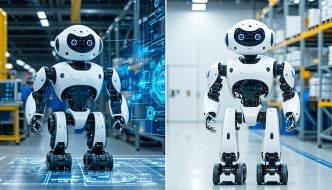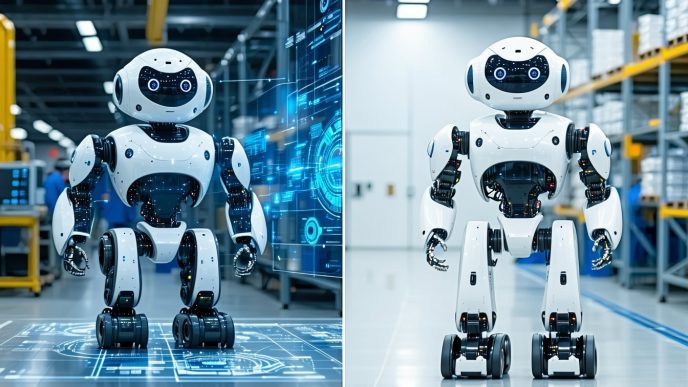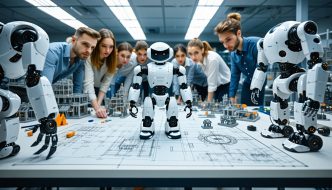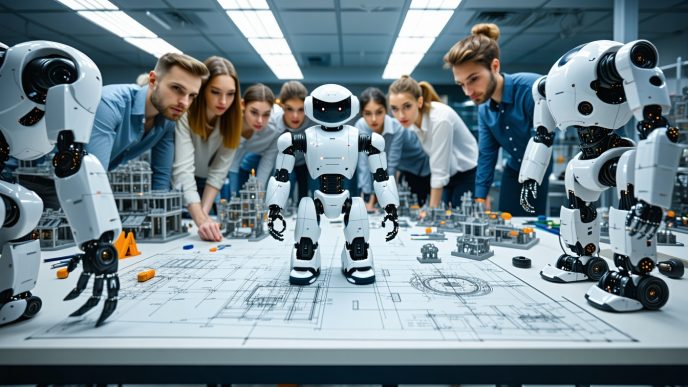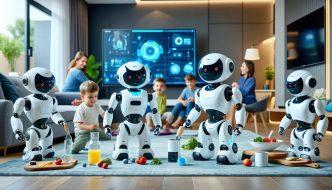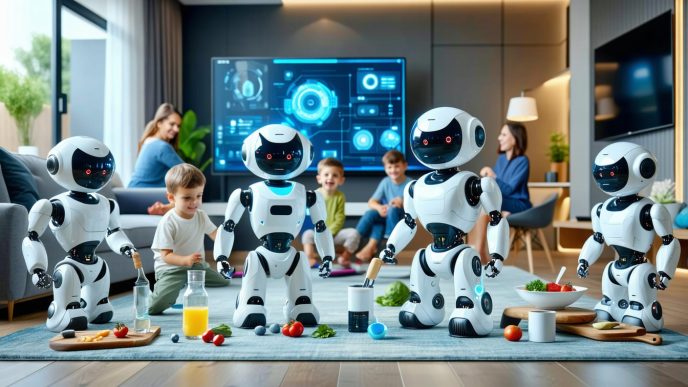Evolution of Humanoid Robots
The journey of humanoid robots is both fascinating and complex. Understanding this evolution helps to appreciate the advancements made in robotics and how they relate to human characteristics.
Historical Perspective
The concept of humanoid robots can be traced back to ancient times. Early inventors and visionaries imagined mechanical beings that could replicate human tasks. Notable examples include:
| Year | Development | Description |
|---|---|---|
| 1770s | Jacques de Vaucanson | Created a mechanical duck that could flap its wings and simulate feeding. |
| 1921 | Karel Čapek | Coined the term “robot” in his play R.U.R. (Rossum’s Universal Robots), which explored the notion of artificial beings. |
| 1950s | George Devol & Joseph Engelberger | Developed the first industrial robot, Unimate, which paved the way for future robotics. |
| 1990s | Honda ASIMO | Introduced a humanoid robot capable of walking and climbing stairs, demonstrating advanced mobility. |
These initial forays laid important groundwork for modern advancements.
Advancements in Humanoid Robotics
The last few decades have seen significant strides in humanoid robotics, with technology rapidly advancing. These improvements focus on enhancing human-like features and functionality. Key advancements include:
| Year | Robot | Description |
|---|---|---|
| 2000 | ASIMO | Featured improved balance, running, and advanced facial recognition. |
| 2011 | iCub | Designed to learn and develop skills similar to a human child, allowing for interaction and adaptability. |
| 2015 | Sophia | Gained fame for her ability to engage in conversations and express emotions, highlighting advancements in AI and facial recognition. |
| 2022 | Tesla Optimus | Focused on practical use in everyday tasks, merging advanced AI with humanoid design. Check out more about the tesla optimus robot. |
The integration of AI, materials science, and engineering has drastically improved the ability of humanoid robots to mimic human movement and behavior. To learn more about how humanoid robots compare to quadrupeds, explore the article on humanoid robots vs quadrupeds.
These historical perspectives and advancements illustrate the remarkable evolution of humanoid robots, setting the stage for future developments in robotics and their integration into society.
Why Do Robots Look Like Humans?
The Concept of Humanoid Robots
Humanoid robots are designed to resemble humans in their appearance and movements. This design choice is intentional, as it allows for more natural interactions between humans and machines. These robots typically have features like a head, arms, and legs, aiming to facilitate communication and functional tasks that mirror human capabilities.
Humanoid robots can be classified based on their design characteristics and functionalities. Below is a table outlining the primary characteristics of humanoid robots.
| Characteristic | Description |
|---|---|
| Appearance | Mimics human body structure |
| Movement | Capable of walking, grasping, and navigating spaces like humans |
| Functionality | Designed for tasks such as assistance, caregiving, and companionship |
| Interaction | Equipped with voice interfaces and emotional recognition capabilities |
The Purpose Behind Humanoid Robot Design
The primary purpose of creating humanoid robots is to enhance user interaction. By mimicking human features, these robots can trigger empathy and make users feel more comfortable when engaging with them. This can be particularly beneficial in settings such as elder care, where humanoid robots provide companionship and support.
Additionally, humanoid robots are often built to perform tasks that require fine motor skills and agility. Robots designed for industries such as healthcare, education, and domestic chores can successfully assist humans by executing specific tasks while navigating environments built for people.
The versatility of humanoid robots extends to various applications. For instance, robots like the sanctuary ai phoenix and the tesla optimus robot showcase advancements in human-robot interactions and task execution. The ongoing development of humanoid robots continues to blur the lines between technology and human-like characteristics, leading to exciting innovations in robotics.
Humanoid robots serve as an essential bridge in understanding and utilizing robotic systems in everyday life. Their design plays a significant role in shaping interactions, making them an integral part of modern robotics. For a deeper look into the distinctions of humanoid robots and quadrupeds, refer to our section on humanoid robots vs quadrupeds.
Advantages of Humanoid Robots
Humanoid robots offer a variety of benefits, particularly in human-robot interaction and their ability to mimic human abilities. Understanding these advantages can help clarify why they continue to gain popularity in various sectors.
Human-Robot Interaction
One of the primary advantages of humanoid robots is their potential to improve human-robot interaction. By resembling human forms, these robots can engage users more intuitively. This familiarity encourages users to communicate and collaborate more effectively with robots.
The following table outlines some of the key benefits of enhanced human-robot interaction:
| Advantage | Description |
|---|---|
| Intuitive Communication | Users can express themselves naturally, leading to more effective exchanges. |
| Emotional Connection | Human-like features foster empathy, allowing users to relate to robots on a personal level. |
| User Engagement | Enhanced interaction keeps users more engaged during tasks or learning processes. |
Mimicking Human Abilities
Humanoid robots are designed to replicate a variety of human movements and functions. This capability allows them to perform tasks that are typically reserved for humans, bridging the gap between machines and human skills.
The specific abilities of humanoid robots include:
| Human Ability | Robotic Equivalent |
|---|---|
| Walking | Humanoid robots can utilize advanced humanoid robot locomotion systems to navigate various environments. |
| Interaction | Equipped with voice interfaces in humanoid robots, they can engage in conversation and respond to commands. |
| Problem Solving | With integration of AI models in humanoid robots, they can analyze situations and make decisions. |
Humanoid robots can serve in multiple applications, ranging from elder care to education, providing companionship and assistance. By mimicking human abilities, these robots enhance the quality of service they offer. For an understanding of their use in different sectors, explore humanoid robots in elder care and humanoid robots in healthcare.
Challenges in Developing Humanoid Robots
Humanoid robots present a unique set of challenges in their development. This section explores two primary hurdles: the engineering and design complexities, as well as the practical applications related to these advanced robots.
Engineering and Design Complexity
Creating humanoid robots involves intricate engineering and sophisticated design techniques. These robots need to replicate the human form and function, which requires precise movement, balance, and coordination.
- Articulation and Movement: Humanoid robots must have joints that mimic human limbs, allowing for a wide range of motion. Designing these joints to work seamlessly while maintaining structural integrity is a significant challenge.
- Balance and Stability: Maintaining balance, especially during walking or running, is crucial. Engineers develop advanced algorithms and sensor systems to ensure stability, similar to the way humans rely on their inner ear and eyesight for balance.
- Materials and Weight Distribution: Selecting materials that are lightweight yet durable is essential to prevent fatigue and enable efficient movement. The design must account for weight distribution, ensuring the robot can support its own structure.
| Challenge Aspect | Description |
|---|---|
| Articulation and Movement | Requires complex joint design for natural motion |
| Balance and Stability | Essential for upright movement, often relying on advanced algorithms and sensors |
| Materials and Weight Distribution | Lightweight and durable materials necessary for optimal performance |
Practical Applications
Humanoid robots have the potential for various applications, but turning the design into reality is difficult. Some key areas of application include:
- Healthcare: Humanoid robots can assist in elder care or rehabilitation, but their design must be user-friendly for patients. Developing robots that can interact empathetically and help with tasks is complex.
- Education: Educational humanoid robots can engage students and facilitate learning experiences. However, integrating effective AI and speech recognition systems poses challenges in delivering coherent and responsive interactions. Understanding emotional cues, as explored in our article on emotion recognition in robots, is crucial.
- Home Assistance: With the demand for humanoid robots in domestic settings, ensuring they can perform household tasks efficiently is vital. They must learn to navigate familiar environments and interact safely with people. Technologies in humanoid robot navigation play a key role in this aspect.
| Application Area | Challenges |
|---|---|
| Healthcare | Need for user-friendly interaction and empathetic assistance |
| Education | Effective AI integration and speech recognition for coherent interactions |
| Home Assistance | Learning to navigate household environments and maintaining safety in interactions with humans |
Addressing these engineering and practical challenges is essential for the development of effective humanoid robots. As innovations in the field continue, the understanding of humanoid robots vs quadrupeds and their respective capabilities will deepen, promoting better designs and applications.
Humanoid Robots vs. Quadrupeds
The evolution of robotic technology has led to the development of various robotic forms, each featuring distinct characteristics and capabilities. In this section, we will analyze the characteristics of humanoid robots and quadruped robots to highlight their differences.
Characteristics of Humanoid Robots
Humanoid robots are designed to resemble the human form, often featuring two arms, two legs, and a head. This design allows them to perform tasks similar to those of humans in various environments.
| Feature | Description |
|---|---|
| Structure | Two arms, two legs, and a head |
| Movement | Bipedal locomotion |
| Interaction | Designed for social interaction |
| Versatility | Capable of performing diverse tasks, such as assistance and companionship |
| Integration with AI | Many humanoids utilize AI for interaction, such as voice interfaces in humanoid robots and emotional recognition capabilities through emotion recognition in robots |
Humanoid robots are increasingly used in various settings, including homes, healthcare, and education, as seen with robots like Ameca by Engineered Arts. They are often designed to work alongside humans, promoting cooperation and support.
Characteristics of Quadruped Robots
Quadruped robots, on the other hand, are designed to mimic the movement of four-legged animals. This design enhances their agility and allows them to navigate diverse terrains effectively.
| Feature | Description |
|---|---|
| Structure | Four legs |
| Movement | Quadrupedal locomotion |
| Stability | Better stability on rough terrain |
| Speed and Agility | Often faster and more agile than humanoid robots |
| Applications | Ideal for exploration, logistics, and search and rescue missions, as demonstrated by robots like Agility Digit and Unitree G1 |
Quadruped robots are frequently used in industries where agility and terrain adaptability are essential. They have shown promise in search and rescue operations, as well as in logistics and delivery systems, making them a valuable asset in various sectors.
The design and functionality of humanoid robots compared to quadruped robots reveal that each serves unique purposes. Humanoids focus on human-like interaction and assistance, while quadrupeds excel in mobility and navigating complex environments. These differences underscore the advancements in robotic technology, allowing for tailored solutions in a variety of fields.
Applications of Humanoid Robots
Humanoid robots are increasingly being used in a variety of industries. Their design and functionality allow them to fit into roles traditionally occupied by humans, making them versatile tools in modern society.
Industries Using Humanoid Robots
Humanoid robots are transforming several sectors. Here are some key industries where these robots are making an impact:
| Industry | Applications |
|---|---|
| Healthcare | Patient companionship and assistance, rehabilitation support, surgeries with precision tools. Explore humanoid robots in healthcare for more details. |
| Education | Interactive learning aides, personalized tutoring, and administrative support. Discover more about humanoid robots for education. |
| Retail and Hospitality | Customer service roles, assisting with inquiries, and enhancing customer experience. |
| Elder Care | Providing companionship and assistance with daily activities. Learn more at humanoid robots in elder care. |
| Security | Surveillance, emergency response, and threat detection. Check humanoid robots for security for insights. |
| Manufacturing | Assembly line tasks, quality control, and logistics support. |
| Research and Development | Advancements in AI and robotics. |
Future Potential in Various Sectors
The future potential for humanoid robots is vast, with various emerging applications across different sectors. Key areas of growth include:
| Sector | Potential Applications |
|---|---|
| Smart Homes | Home automation, assistance in chores, and home security. Explore humanoid robots for daily chores for insights. |
| Companion Robots | Providing emotional support and interaction for mental well-being. |
| Customization | Tailored robots for specific tasks, like humanoid robot customization. |
| Remote Work | Assisting with tasks and communication in remote work environments. Learn more about humanoid robots and remote work. |
| Logistics | Streamlining supply chains and inventory management. Check humanoid robots in logistics for more information. |
| Entertainment | Engaging interactions in gaming, theme parks, and events. |
As advancements continue in robotics, humanoid robots are expected to play a significant role in shaping the landscape of various industries, simplifying tasks and enhancing human experiences. Their comparative advantages over other types of robots, as explored in the context of humanoid robots vs quadrupeds, will further define their integration into everyday life.
Ethical and Social Considerations
As humanoid robots become more integrated into society, their impact raises various ethical and social considerations. These implications span numerous sectors and can significantly influence how humans interact with technology.
Impact on Society
Humanoid robots have the potential to transform everyday life. They can assist in various domains, including home chores, elder care, education, and even companionship. The introduction of robots into these spaces may affect job markets and force changes in workforce dynamics. For instance, while robots may alleviate certain labor shortages, they can also displace jobs traditionally held by humans.
The deployment of humanoid robots in public spaces introduces new societal norms regarding privacy and trust. As people engage more with robots, their perceptions of companionship and social interaction can evolve, blurring the lines between human relationships and those with machines. A study may resemble the following:
| Impact Area | Potential Effects |
|---|---|
| Job Market | Automation of certain tasks |
| Human Interaction | New forms of companionship |
| Privacy Concerns | Increased monitoring and data collection |
| Ethical Frameworks | Need for guidelines on robot behavior |
Ethical Dilemmas and Discussions
The rise of humanoid robots introduces complex ethical dilemmas that warrant discussions among engineers, ethicists, and society at large. Questions regarding the rights and responsibilities of robots are prevalent, especially in scenarios where they interact closely with humans.
One pressing concern is the ethical implications of creating robots that can mimic human emotions or behaviors. If a robot communicates effectively with individuals, does it have obligations? How should society handle robots that fail to meet expectations or cause harm? This raises the necessity for safety systems and clear ethical guidelines in robot development, as discussed in our articles on humanoid robot safety systems and robot emotions and ethics.
Furthermore, issues surrounding privacy arise when humanoid robots are employed in personal or sensitive environments. The potential for data collection by these robots necessitates discussions about user consent, data storage, and the implications of such technologies in maintaining personal privacy. This is crucial as society navigates the intricate relationship between technology and individual rights.
As developers and society continue to navigate these ethical and social considerations, it becomes essential to establish a framework that guides the interaction between humans and robots. By doing so, they can strive to maximize the benefits of humanoid robots while addressing potential risks.

